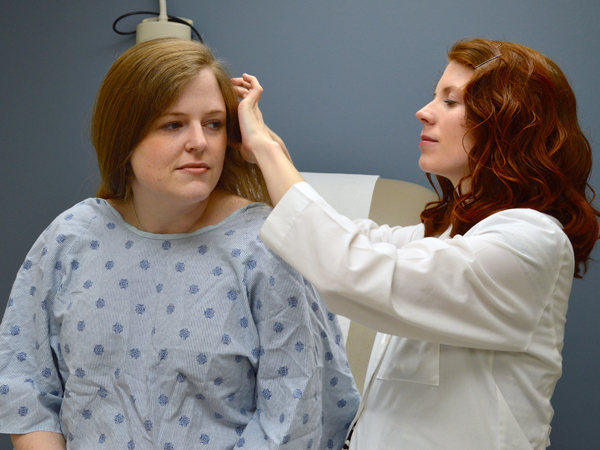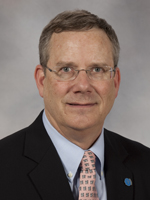When it comes to skin cancer, prevention is key

Published in News Stories on May 21, 2015
At 37, Amanda Gentry is taking precautions to avoid skin cancer.
She was among 121 people who took advantage of a free skin cancer screening offered May 19 by the University of Mississippi Medical Center's Department of Dermatology.
"I'm here because I have lily white skin and when I was younger, I was stupid," she said. "I used tanning beds and as a child I got burned a lot."
Her proactive stance now is exactly what dermatologists want to see, said Dr. Stephen Helms, a professor in the dermatology department.
"The main thing is to offer people a free screening," he said. "At the same time, we're going to try to bring more awareness to people about skin cancer."
As they have for years, UMMC dermatologists emphasize taking action to avoid skin cancer and for those at highest risk to be screened regularly for it.
The screening came as part of the American Academy of Dermatology's National Skin Cancer Month held each May and its SPOT Skin Cancer Program. UMMC dermatologists and staff as well as others involved in skin cancer care or cancer screenings helped coordinate and operate the screening. The American Cancer Society Mississippi office also offered help in registering those to be screened.
Participants saw one of seven faculty members, four residents or nurse practitioner doing the screening, received a record of any suspicious areas found on their body and could pick up a list of all area dermatologists if the screening physician recommended they seek further help.
They also were offered sun screen lotion and information on ways to lower their skin cancer risks.
As summer approaches, dermatologists and others on the UMMC skin care team are warning Mississippians to enjoy the sun safely.
"Our first goal is always to help people avoid cancer when possible," said Dr. Srinivasan Vijayakumar, Cancer Institute director and chair of the Department of Radiation Oncology. "If that's not possible, we want to find it early when it's most treatable."

Brodell
Dr. Robert Brodell, professor and chair of the Department of Dermatology said many skin cancers are preventable. Time in the sun, whether for work or play, is a prime risk factor for skin cancer. That means people who limit their exposure to morning and evenings and who use the appropriate sunscreen lower their risk for all skin cancers.
Skin cancer occurs more often in people who have light hair, eyes and complexions and who do not tan easily. Darker skinned people may still get skin cancers and should be alert for melanoma, particularly on the palms of their hands, soles of their feet and in their mouth.
Brodell offers these tips for lowering skin cancer risk:
- Wear broad-brimmed hats.
- Stay in the shade from 10 a.m. to 2 p.m. when ultraviolent rays are strongest.
- Wear sun screens with sun protection factors of SPF 30 or higher, also labeled broad spectrum UVA-UVB blockers.
- Reapply sun screens every two to three hours, especially if you are swimming or sweating.
- Wear sunglasses with UV protection.
- Check your body on the first day of every month for new growths, changing moles or sores that will not heal. Find a partner who can check your back.
- Show such suspicious spots to your primary care physician or dermatologist.
And Gentry? She smiled as she waved her paperwork depicting where on her body Dr. Stephanie Jacks, an assistant professor of dermatology, found two small slightly suspicious areas. Glancing at her husband, she said she will follow up with a dermatologist as recommended.

Additional information:
Find out more about skin cancer: https://www.ummchealth.com/skincancer/
Find out how to screen yourself for skin cancer: https://www.ummchealth.com/cancerscreen/
American Academy of Dermatology: https://www.aad.org/spot-skin-cancer


